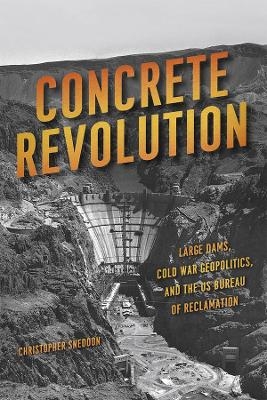
Concrete Revolution
Large Dams, Cold War Geopolitics, and the US Bureau of Reclamation
Seiten
2015
University of Chicago Press (Verlag)
978-0-226-28431-6 (ISBN)
University of Chicago Press (Verlag)
978-0-226-28431-6 (ISBN)
Water may seem innocuous, but as a universal necessity, it inevitably intersects with politics when it comes to acquisition, control, and associated technologies. While we know a great deal about the socio-ecological costs and benefits of modern dams, we know far less about their political origins and ramifications. In Concrete Revolution, Christopher Sneddon offers a corrective: a compelling historical account of the US Bureau of Reclamation's contributions to dam technology, Cold War politics, and the social and environmental adversity perpetuated by the US government in its pursuit of economic growth and geopolitical power. Founded in 1902, the Bureau became enmeshed in the US State Department's push for geopolitical power following World War II, a response to the Soviet Union's increasing global sway. By offering technical and water resource management advice to the world's underdeveloped regions, the Bureau found that it could not only provide them with economic assistance and the United States with investment opportunities, but also forge alliances and shore up a country's global standing in the face of burgeoning communist influence.
Drawing on a number of international case studies-from the Bureau's early forays into overseas development and the launch of its Foreign Activities Office in 1950 to the Blue Nile investigation in Ethiopia-Concrete Revolution offers insights into this historic damming boom, with vital implications for the present. If, Sneddon argues, we can understand dams as both technical and political objects rather than instruments of impartial science, we can better participate in current debates about large dams and river basin planning.
Drawing on a number of international case studies-from the Bureau's early forays into overseas development and the launch of its Foreign Activities Office in 1950 to the Blue Nile investigation in Ethiopia-Concrete Revolution offers insights into this historic damming boom, with vital implications for the present. If, Sneddon argues, we can understand dams as both technical and political objects rather than instruments of impartial science, we can better participate in current debates about large dams and river basin planning.
Christopher Sneddon is associate professor of geography and environmental studies at Dartmouth College. He lives in White River Junction, VT.
| Sprache | englisch |
|---|---|
| Maße | 16 x 23 mm |
| Gewicht | 567 g |
| Themenwelt | Geisteswissenschaften ► Geschichte ► Regional- / Ländergeschichte |
| Geschichte ► Teilgebiete der Geschichte ► Technikgeschichte | |
| Naturwissenschaften ► Geowissenschaften ► Geografie / Kartografie | |
| Sozialwissenschaften ► Politik / Verwaltung | |
| Technik ► Bauwesen | |
| Wirtschaft ► Betriebswirtschaft / Management ► Rechnungswesen / Bilanzen | |
| ISBN-10 | 0-226-28431-X / 022628431X |
| ISBN-13 | 978-0-226-28431-6 / 9780226284316 |
| Zustand | Neuware |
| Haben Sie eine Frage zum Produkt? |
Mehr entdecken
aus dem Bereich
aus dem Bereich
Buch | Softcover (2024)
Lehmanns Media (Verlag)
CHF 27,90
Digitalisierung neu denken für eine gerechte Gesellschaft
Buch | Hardcover (2023)
Quadriga (Verlag)
CHF 27,95
Vom Perceptron zum Deep Learning
Buch | Softcover (2022)
Springer Vieweg (Verlag)
CHF 27,95


